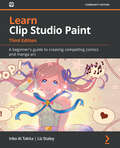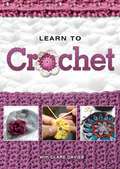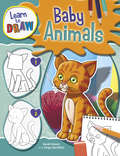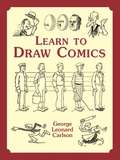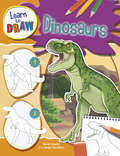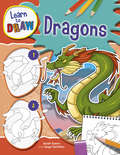- Table View
- List View
Lean Construction: Core Concepts and New Frontiers
by Patricia Tzortzopoulos Michail Kagioglou Lauri KoskelaThis book collates the main research developments around Lean Construction over the past 25 years with contributions from many seminal authors in the field. It takes stock of developments since the publication of Koskela’s (1992) Application of the New Production Philosophy to Construction and, in doing so, challenges current thinking and progress. It also crystallises theoretical conceptualisations and practically situated learning whilst identifying future research challenges, agendas and opportunities for global collaborative actions. The contributors present the development of Lean Construction as a fundamental part of improving construction productivity, quality and delivery of value to clients and users of built infrastructure. In doing so, the book introduces the reader to the foundational principles and theories that have influenced the way we now understand Lean Construction and has provided very useful insights to students, practitioners and researchers on key junctures over the last 25 years. Highlighting the key contemporary developments and using global case study material the chapters demonstrate good practice but also help introduce new thinking to both lay readers and experienced practitioners alike. This book is essential reading for undergraduate and postgraduate students, researchers and practitioners with an interest in Lean Construction and construction management, providing a general understanding of the area, current state of the art knowledge as well as providing an insight into areas for future research.
Lean Project Delivery and Integrated Practices in Modern Construction
by Lincoln H. Forbes Syed M. AhmedLean Project Delivery and Integrated Practices in Modern Construction is the new and enhanced edition of the pioneering book Modern Construction by Lincoln H. Forbes and Syed M. Ahmed. This book provides a multi-faceted approach for applying lean methodologies to improve design and construction processes. Recognizing the wide diversity in the landscape of projects, and encompassing private and public sector activity, buildings and infrastructure, the book expands upon the detailed coverage of integrated project delivery and new lean tools and techniques to include: Greater emphasis on the importance of creating a lean culture and the initiatives required to transform the industry; Expanded discussions of the foundational writings in lean construction theory; Exploration of the synergies between "lean" and "green" initiatives; Specific procedures for modifying planning and scheduling activities to improve the performance of the project team; Expanded sections on quality, and topics that have become a part of the lean lexicon, such as Choosing by Advantages, "line of balance"/location-based scheduling, virtual design teams, takt time planning and set-based design; Discussion questions for beginners and advanced lean practitioners; and Improved cross-referencing within the text to help the reader navigate the frameworks, techniques and tools to support the application of lean principles. The techniques described here enhance the use of resources, reducing waste, minimizing delays, increasing quality and reducing overall costs. They enable practitioners to improve the quality of the built environment, secure higher levels of customer/owner satisfaction, and simultaneously improve their profitability. This book is essential reading for all those wanting to be at the forefront of construction management and lean thinking.
Lean Project Delivery and Integrated Practices in Modern Construction
by Lincoln H. Forbes Syed M. AhmedLean Project Delivery and Integrated Practices in Modern Construction is the new and enhanced edition of the pioneering book Modern Construction by Lincoln H. Forbes and Syed M. Ahmed. This book provides a multi-faceted approach for applying lean methodologies to improve design and construction processes. Recognizing the wide diversity in the landscape of projects, and encompassing private and public sector activity, buildings and infrastructure, the book expands upon the detailed coverage of integrated project delivery and new lean tools and techniques to include: Greater emphasis on the importance of creating a lean culture and the initiatives required to transform the industry; Expanded discussions of the foundational writings in lean construction theory; Exploration of the synergies between "lean" and "green" initiatives; Specific procedures for modifying planning and scheduling activities to improve the performance of the project team; Expanded sections on quality, and topics that have become a part of the lean lexicon, such as Choosing by Advantages, "line of balance"/location-based scheduling, virtual design teams, takt time planning and set-based design; Discussion questions for beginners and advanced lean practitioners; and Improved cross-referencing within the text to help the reader navigate the frameworks, techniques and tools to support the application of lean principles. The techniques described here enhance the use of resources, reducing waste, minimizing delays, increasing quality and reducing overall costs. They enable practitioners to improve the quality of the built environment, secure higher levels of customer/owner satisfaction, and simultaneously improve their profitability. This book is essential reading for all those wanting to be at the forefront of construction management and lean thinking.
Leap Motion Development Essentials
by Mischa SpiegelmockThis book is a fast-paced guide with practical examples that aims to help you understand and master the Leap Motion SDK.This book is for developers who are either involved in game development or who are looking to utilize Leap Motion technology in order to create brand new user interaction experiences to distinguish their products from the mass market. You should be comfortable with high-level languages and object-oriented development concepts in order to get the most out of this book.
Learn Autodesk Inventor 2018 Basics: 3D Modeling, 2D Graphics, and Assembly Design
by T. KishoreGet started with the basics of part modeling, assembly modeling, presentations, and drawings in this step-by-step tutorial on Autodesk Inventor fundamentals. Next, this book teaches you some intermediate-level topics such as additional part modeling tools, sheet metal modeling, top-down assembly features, assembly joints, and dimension and annotations. Engaging explanations, practical examples, and step-by-step instructions make this tutorial book complete. Once you have read Learn Autodesk Inventor 2018 Basics you will be able to use Autodesk Inventor for 3D modeling, 2D drawings, finite element analysis, mold design, and other purposes, just like a design professional. You will gain all the basic information and essential skills you need to work in Autodesk Inventor immediately.What You'll LearnCarry out virtual 3D modeling for your next 3D printing projectsDesign molds for 3D printing and other projectsGenerate 2D drawingsWho This Book Is ForNovice users of Autodesk Inventor.
Learn Clip Studio Paint: Create Impressive Comics And Manga Art In World-class Graphics Software, 2nd Edition
by Liz StaleyLearning a new software can be daunting, especially graphics one. Even if you’re fluent in graphics software, switching to a new one can be a challenge. This book makes the transition to creating art in a digital environment easier with Clip Studio Pro. From installing the program to customizing tools and beginning an animation, learn the tips and tricks of using this software that is taking the digital art world by storm.
Learn Clip Studio Paint (PDF): A Beginners Guide To Creating Compelling Comics And Manga Art
by Inko Liz StaleyDiscover the tools to tell your own manga story with Clip Studio Paint and develop your digital drawing skills Key Features Gain a clear understanding of Clip Studio Paint and create your own manga stories Learn to put CSP into practice by implementing it in real-world drawing scenarios Discover how to apply digital drawing techniques to your creation using CSP Book Description Clip Studio Paint is a versatile digital painting program for creating manga and illustrations, helping artists expand their digital portfolio. This software is packed with tools that make panel laying, speech adding, toning, and editing much easier. This easy-to-follow guide is clearly divided into chapters covering drawing tools, interface customization, and using various visual effects so you can focus on specific techniques in detail one at a time. Learn Clip Studio Paint is a comprehensive introduction for those who are new to Clip Studio Paint that will have you up to speed in no time. You'll start by experiencing what it's like to create manga digitally and find new ways to shape your drawing. Next, using practical tips and rich visual references, the book shows you how to apply techniques to your creations, giving you the opportunity to expand your range of visual expression. As you advance, you'll explore how to create special effect brushes using an in-depth example, along with discovering how to color, blend, and edit your art digitally. Finally, you'll find out how to print, use the Clip Studio Paint Assets, and learn how to create unique and inspiring art that stands out from the rest. By the end of this Clip Studio Paint book, you'll have gained a clear understanding of its tools and be able to start telling your own manga story using your improved digital drawing skills. What you will learn Explore Clip Studio Paint and create your own manga stories Familiarize yourself with the CSP ecosystem Use Clip Studio Paint Pro's inking tools and find ways to customize your art Explore the flexibility of the brush engine in Clip Studio Paint Pro Use palettes to generate colors between foreground and background colors Find out alternative ways of coloring your manga art using black, white, and grey Discover how to use layer blending to add textures to your images Who this book is for If you're just starting out as a digital artist or want to switch to Clip Studio Paint from a different graphics software package, then this book is for you. Those with no prior knowledge of digital art or intermediate-level users looking to explore the unique features of Clip Studio Paint will also find this book useful.
Learn D3.js 5: Create Interactive Data-driven Visualizations For The Web With The D3. Js Library
by Helder Da RochaThis book is a practical Hands-On introduction to create and publish your own interactive data visualization projects on the web-even if you have little or no experience with data visualization or web development. The purpose of this book is to teach developers how to create beautiful, efficient and interactive data visualizations for the Web.
Learn ggplot2 Using Shiny App (Use R!)
by Keon-Woong MoonThis book and app is for practitioners, professionals, researchers, and students who want to learn how to make a plot within the R environment using ggplot2, step-by-step without coding.In widespread use in the statistical communities, R is a free software language and environment for statistical programming and graphics. Many users find R to have a steep learning curve but to be extremely useful once overcome. ggplot2 is an extremely popular package tailored for producing graphics within R but which requires coding and has a steep learning curve itself, and Shiny is an open source R package that provides a web framework for building web applications using R without requiring HTML, CSS, or JavaScript. This manual—"integrating" R, ggplot2, and Shiny—introduces a new Shiny app, Learn ggplot2, that allows users to make plots easily without coding. With the Learn ggplot2 Shiny app, users can make plots using ggplot2 without having to code each step, reducing typos and error messages and allowing users to become familiar with ggplot2 code. The app makes it easy to apply themes, make multiplots (combining several plots into one plot), and download plots as PNG, PDF, or PowerPoint files with editable vector graphics. Users can also make plots on any computer or smart phone.Learn ggplot2 Using Shiny App allows users toMake publication-ready plots in minutes without codingDownload plots with desired width, height, and resolutionPlot and download plots in png, pdf, and PowerPoint formats, with or without R code and with editable vector graphics
Learn JavaScript with p5.js: Coding for Visual Learners
by Engin ArslanLearn coding from scratch in a highly engaging and visual manner using the vastly popular JavaScript with the programming library p5.js. The skills you will acquire from this book are highly transferable to a myriad of industries and can be used towards building web applications, programmable robots, or generative art. You'll gain the proper context so that you can build a strong foundation for programming. This book won’t hinder your momentum with irrelevant technical or theoretical points. The aim is to build a strong, but not overly excessive knowledge to get you up and running with coding. If you want to program creative visuals and bring that skill set to a field of your your choice, then Learn JavaScript with p5.js is the book for you.What You'll LearnCode from scratch and create computer graphics with JavaScript and the p5.js libraryGain the necessary skills to move into your own creative projectsCreate graphics and interactive experiences using ProcessingProgram using JavaScript and p5.js and secondarily in creating visualsWho This Book is ForArtists or a visual designers. Also, those who want to learn the fundamentals of programming through visual examples.
Learn Oils Quickly: A Practical Step-by-step Guide To Learning To Paint People In Watercolour And Oils (Learn Quickly Ser. #02)
by Hazel SoanLearn OpenGL: Beginner's guide to 3D rendering and game development with OpenGL and C++
by Frahaan HussainA step-by-step instructional guide to understanding the fundamentals of game development with OpenGL. Right from the setup to the important features, we'll get a better understanding of games and the engines behind them. Key Features Learn the basics of drawing along with fundamentals of shading to create amazing objects. Get in-depth knowledge of lighting and materials to make realistic objects. Understand the fundamentals of model loading and cube mapping. Book Description Learn OpenGL is your one-stop reference guide to get started with OpenGL and C++ for game development. From setting up the development environment to getting started with basics of drawing and shaders, along with concepts such as lighting, model loading, and cube mapping, this book will get you up to speed with the fundamentals. You begin by setting up your development environment to use OpenGL on Windows and macOS. With GLFW and GLEW set up using absolute and relative linking done, you are ready to setup SDL and SFML for both the operating systems. Now that your development environment is set up, you'll learn to draw using simple shaders as well as make the shader more adaptable and reusable. Then we move on to more advanced topics like texturing your objects with images and transforming your objects using translate, rotate and scale. With these concepts covered, we'll move on to topics like lighting to enable you to incorporate amazing dynamic lights in your game world. By the end of the book, you'll learn about model loading, right from setting up ASSIMP to learning about the model class and loading a model in your game environment. We will conclude by understanding cube mapping to bring advance worlds to your game. What you will learn Set up GLFW and GLEW on Windows and macOS with absolute, relative Linking Set up SDL and SFML on your system using absolute and relative Linking Draw using the simple shaders Create a camera and learn to populate your game world with objects Learn about color and lighting concepts to create an amazing game world Understand model loading and cube mapping to advance your game Who this book is for This book is targeted towards anyone and everyone who is interested in creating games, learning how game engines work and most importantly for anyone who is interested in learning OpenGL. The ideal reader for this book would be anyone with a passion for learning game development or looking out for an OpenGL reference guide. The skills that you'll learn in this book will be applicable to all your game development needs. You'll require a strong foundation in C++ to understand and apply the concepts of this book.
Learn OpenGL: Beginner's guide to 3D rendering and game development with OpenGL and C++
by Frahaan HussainA step-by-step instructional guide to understanding the fundamentals of game development with OpenGL. Right from the setup to the important features, we'll get a better understanding of games and the engines behind them. Key Features Learn the basics of drawing along with fundamentals of shading to create amazing objects. Get in-depth knowledge of lighting and materials to make realistic objects. Understand the fundamentals of model loading and cube mapping. Book Description Learn OpenGL is your one-stop reference guide to get started with OpenGL and C++ for game development. From setting up the development environment to getting started with basics of drawing and shaders, along with concepts such as lighting, model loading, and cube mapping, this book will get you up to speed with the fundamentals. You begin by setting up your development environment to use OpenGL on Windows and macOS. With GLFW and GLEW set up using absolute and relative linking done, you are ready to setup SDL and SFML for both the operating systems. Now that your development environment is set up, you'll learn to draw using simple shaders as well as make the shader more adaptable and reusable. Then we move on to more advanced topics like texturing your objects with images and transforming your objects using translate, rotate and scale. With these concepts covered, we'll move on to topics like lighting to enable you to incorporate amazing dynamic lights in your game world. By the end of the book, you'll learn about model loading, right from setting up ASSIMP to learning about the model class and loading a model in your game environment. We will conclude by understanding cube mapping to bring advance worlds to your game. What you will learn Set up GLFW and GLEW on Windows and macOS with absolute, relative Linking Set up SDL and SFML on your system using absolute and relative Linking Draw using the simple shaders Create a camera and learn to populate your game world with objects Learn about color and lighting concepts to create an amazing game world Understand model loading and cube mapping to advance your game Who this book is for This book is targeted towards anyone and everyone who is interested in creating games, learning how game engines work and most importantly for anyone who is interested in learning OpenGL. The ideal reader for this book would be anyone with a passion for learning game development or looking out for an OpenGL reference guide. The skills that you'll learn in this book will be applicable to all your game development needs. You'll require a strong foundation in C++ to understand and apply the concepts of this book.
Learn Origami
by Nick RobinsonOrigami is a Japanese word that means “folding paper”. It’s both a craft, accessible to all and an art, taken to perfection by a few Few resources are needed, other than a flat surface and some paper and over the past 50 years it has turned from an obscure hobby to a world-wide passion for thousands of people. You don’t need endless patience or talent – anyone of almost any age can make simple models to delight themselves and their friends. Origami is a hobby enjoyed all around the world. In this book, professional Origamist Nick Robinson shows you a series of classic simple designs. Follow Nick’s diagrams and with a few sheets of paper a lifetime of fun awaits you! Take a sheet, get folding!
Learn RPGs in GameMaker: Build and Design Role Playing Games
by Ben TyersCarry out the pre-planning, design, and programming of role playing games (RPGs) using the popular GameMaker: Studio in this very practical and fun book. Author Ben Tyers teaches you how to create a story or plotline for the RPG, apply aesthetics, and develop core and extended gameplay. Using Learn RPGs in GameMaker: Studio, you can design and build your own RPG using the GameMaker: Studio platform. Build your first game application and deploy in an app store, on Facebook, or just on a PC. Maybe, even, make a few bucks. What You'll Learn Use the GameMaker: Studio platform to design and build a role playing game Create a story for game design purposes, using a plot line and defining characters Discover the impact of aesthetics on art style, character separation, scene development, sound design and views Master core gameplay elements such as battles, exploration, scoring, and endings Work with extended gameplay elements such as collectibles, quirks, management, and saving Employ the various core and extended gameplay elements as appropriate to your RPG Who This Book Is For Game designers or developers looking to design and build their first role playing game using the GameMaker: Studio platform.
Learn Three.js: Programming 3d Animations And Visualizations For The Web With Html5 And Webgl, 3rd Edition
by Jos DirksenThis is a practical, example rich book that will help you in learning all the features of Three.js. With this book you’ll learn how to create and animate beautiful looking 3D scenes directly in your browser utilizing the full potential of WebGL and modern browsers, without having to learn WebGL.
Learn to Crochet
by Clare DaviesLearn to Crochet Learn to crochet with me Clare Davies – crochet teacher at The Gilliangladrag Fluff-a-torium. I like to think I’m a patient knitting and crochet teacher and I hope this lesson from me in the studio, to you in the comfort of your home (or wherever you fancy crocheting) will be an easy to follow and enjoyable experience. In this beautifully illustrated little book, I will share with you the basics to get you started, and then move you on to some simple projects to practice what you’ve learnt. Find out what equipment you’ll need, learn different crochet stitches and even how to make bunting and a crochet basket! Then I will talk you through finishing techniques to complete your creations. You’ll be crocheting in no time!
Learn to Crochet Granny Squares and Flower Motifs: 26 projects to get you started
by Nicki TrenchGranny squares are the perfect crochet project for beginners. They are easy to learn and quick to complete.With full instructions for all the techniques you will need at the start, followed by 25 lovely patterns to put your newly-learned skills to use, Learn to Crochet Granny Squares and Flower Motifs is the perfect book for beginners, and near-beginners who want to expand their repertoire. The repetition of stitches and patterns within granny squares is perfect for mastering the basics, and the squares can then be made up into all sorts of useful and beautiful things, from scarves and blankets to bags and cushion covers. Once you've got the hang of squares, branch out into hexagons and triangles, and then into flower motifs – the combinations of shape, colour and pattern are almost endless. Best of all, you can use up all sorts of yarn from your stash as you practise until your squares are perfect.
Learn to Crochet Granny Squares and Flower Motifs: 25 projects to get you started
by Nicki TrenchGranny squares are the perfect crochet project for beginners. They are easy to learn and quick to complete.With full instructions for all the techniques you will need at the start, followed by 25 lovely patterns to put your newly-learned skills to use, Learn to Crochet Granny Squares and Flower Motifs is the perfect book for beginners, and near-beginners who want to expand their repertoire. The repetition of stitches and patterns within granny squares is perfect for mastering the basics, and the squares can then be made up into all sorts of useful and beautiful things, from scarves and blankets to bags and cushion covers. Once you've got the hang of squares, branch out into hexagons and triangles, and then into flower motifs – the combinations of shape, colour and pattern are almost endless. Best of all, you can use up all sorts of yarn from your stash as you practise until your squares are perfect.
Learn to Draw: 10-Week Course for Aspiring Artists
by Barrington BarberLearning to draw will be a pleasure with this 10-week course, packed with clear step-by-step exercises and inspirational examples. Each week focuses on a different area of drawing, from initial mark-making to portraits and landscapes, so that you can gradually build your skills and discover the subjects that interest you.Barrington Barber takes as his starting point the belief that, with regular practice and enthusiasm, anyone can learn to draw and learn to draw well. After 10 weeks following the exercises in this book, you will be amazed at what you can achieve.
Learn to Draw Baby Animals: Baby Animals (Learn to Draw #6)
by Jorge SantillanLearn to Draw: Baby Animals shows children how to draw six adorable young animals, from puppies, kittens and bunnies to lambs, foals and chicks. Each drawing is broken down into seven simple, easy-to-follow steps to help children create, and then colour in, their own baby animal pictures. Fact boxes on each spread provide information about each baby animal, allowing children to learn about, as well as to draw, them. A glossary at the back of the book explains any complicated words, and a 'More Information' section gives suggestions as to how children can find out more about baby animals.If children have loved learning to draw baby animals, why not try learning to draw dinosaurs, dragons, fairies, mermaids, unicorns, knights, castles, pirates and pirate ships in other titles in the series?
Learn to Draw Comics
by George Leonard CarlsonThis user-friendly guide from the 1930s offers aspiring cartoonists a wealth of practical advice. Rich in period flavor, it supplies the ageless foundations of comic art. Abundant illustrations and clear, nontechnical prose cover: creating expressions, attaining proportion and applying perspective, depicting anatomy, simple shading, achieving consistency, lettering, and writing a strip.
Learn to Draw Dinosaurs: Dinosaurs (Learn to Draw #5)
by Jorge SantillanLearn to Draw: Dinosaurs shows children how to draw six incredible dinosaurs, from T-rex, Stegosaurus and Diplodocus to Triceratops, Velociraptor and Allosaurus. Each drawing is broken down into seven simple, easy-to-follow steps to help children create, and then colour in, their own dinosaur pictures. Fact boxes on each spread provide information about each dinosaur, allowing children to learn about, as well as to draw, them. A glossary at the back of the book explains any complicated words, and a 'More Information' section gives suggestions as to how children can find out more about dinosaurs.If children have loved learning to draw dinosaurs, why not try learning to draw baby animals, dragons, fairies, mermaids, unicorns, knights, castles, pirates and pirate ships in other titles in the series?
Learn to Draw: Dragons (PDF)
by Jorge SantillanLearn to Draw: Dragons shows children how to draw six incredible dragons, from magical, wicked and flying dragons to fire-breathing, water and Chinese dragons. Each drawing is broken down into seven simple, easy-to-follow steps to help children create, and then colour in, their own dragon pictures. Fact boxes on each spread provide information about dragons, allowing children to learn about, as well as to draw, them. A glossary at the back of the book explains any complicated words, and a 'More Information' section gives suggestions as to how children can find out more about dragons and dragon myths.





